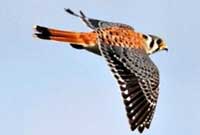The American kestrel is the smallest bird of the Falcons family. This small hawk occurs in North America, where it is the most familiar and widespread falcon. It is also found in Central and South America, The Bahamas and the Antilles. It is regarded as Least Concern in the Red List of the Union for Conservation of Nature (IUCN), which includes abundant and widespread taxa.
In Cuba, it is a common, permanent and winter resident. The Cuban race and wintering birds from North America are slightly different regarding the colors of chest and belly. Unlike most bird species, they frequently perch at the tip of palm trees. They are often seen on lamp posts and high tree branches with no foliage.
The American kestrel makes use of a wide variety of habitats, particularly open or semi-open spaces. They inhabit cities, farmlands, forest edges, roads and even deserts. They live anywhere they can find prey and high perches. In Cuba, it is the most abundant and has the widest distribution of all raptor species, because of the aforementioned habitat versatility. Insects, birds, bats, lizards, spiders and other creatures are among the favorite prey.
However, this bird species had not been reported for the Jardines de la Reina Archipelago until November 2017. Antonio Garcia Quinta, a young but talented scientist from the Coastal Ecosystems Research Center (CIEC) continues to yield amazing results in his short but successful career as a researcher. He sighted this wonderful bird in the sandy shrubs of Cayo Caballones, in the Jardines de la Reina National Park. It was a mature female, probably transient, that was feeding and resting at this spot during the fall migration.
With this sighting, the number of bird species of the park reaches 118, and calls for further efforts in an area that may be home to many other animal species. The land ecosystems of the park have not been largely surveyed for different reasons, particularly logistic-related ones. But every single effort, however limited, has paid off.
The Oceans for Youth Vessel has become an ideal platform where tourism, education and research have merged to unveil a lot more about the values of Jardines de la Reina. What has been numbered and characterized so far could be like the tip of an iceberg, particularly in the terrestrial ecosystems. The comprehensive approach of the OFY programs will lead to new and important findings that may pave the way to diversify the tourist attractions of this wonderful place.
Photo credit: www.nenature.com



